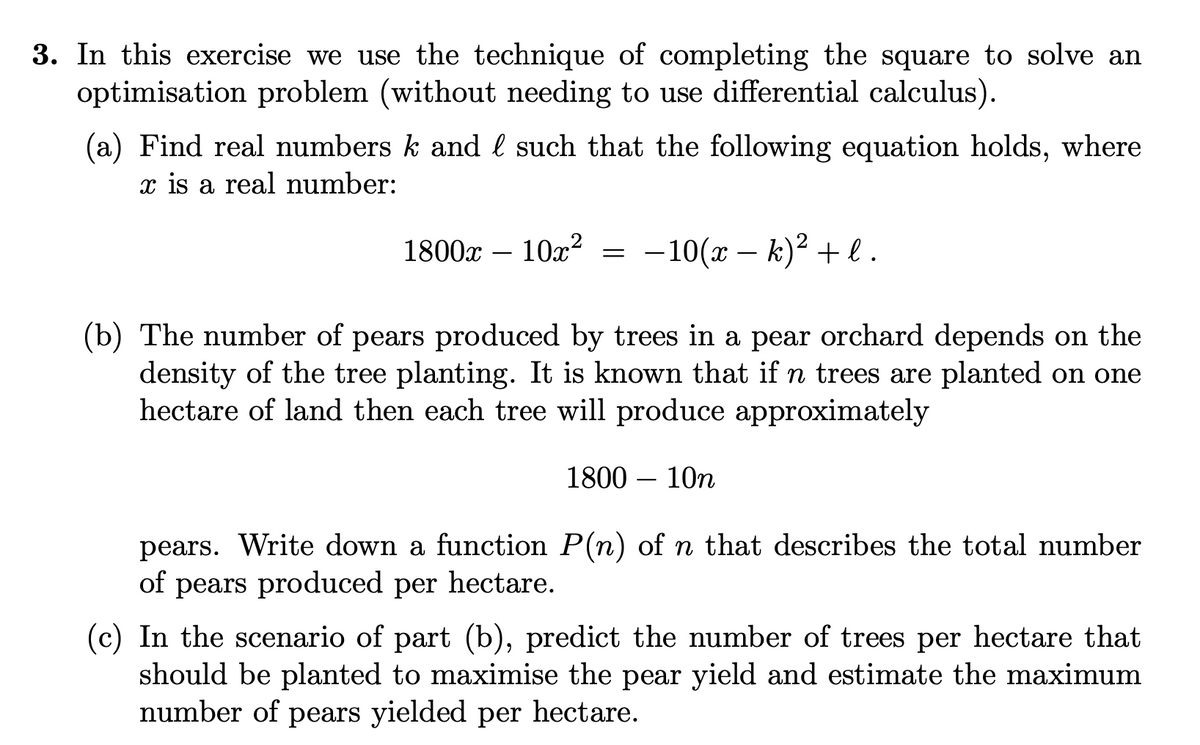3. In this exercise we use the technique of completing the square to solve an optimisation problem (without needing to use differential calculus). (a) Find real numbers k and l such that the following equation holds, where x is a real number: 1800x – 10x? -10(x – k)? + l . (b) The number of pears produced by trees in a pear orchard depends on the density of the tree planting. It is known that if n trees are planted on one hectare of land then each tree will produce approximately 1800 – 10n pears. Write down a function P(n) of n that describes the total number of pears produced per hectare. (c) In the scenario of part (b), predict the number of trees per hectare that should be planted to maximise the pear yield and estimate the maximum number of pears yielded per hectare.
3. In this exercise we use the technique of completing the square to solve an optimisation problem (without needing to use differential calculus). (a) Find real numbers k and l such that the following equation holds, where x is a real number: 1800x – 10x? -10(x – k)? + l . (b) The number of pears produced by trees in a pear orchard depends on the density of the tree planting. It is known that if n trees are planted on one hectare of land then each tree will produce approximately 1800 – 10n pears. Write down a function P(n) of n that describes the total number of pears produced per hectare. (c) In the scenario of part (b), predict the number of trees per hectare that should be planted to maximise the pear yield and estimate the maximum number of pears yielded per hectare.
Calculus: Early Transcendentals
8th Edition
ISBN:9781285741550
Author:James Stewart
Publisher:James Stewart
Chapter1: Functions And Models
Section: Chapter Questions
Problem 1RCC: (a) What is a function? What are its domain and range? (b) What is the graph of a function? (c) How...
Related questions
Question

Transcribed Image Text:3. In this exercise we use the technique of completing the square to solve an
optimisation problem (without needing to use differential calculus).
(a) Find real numbers k and l such that the following equation holds, where
x is a real number:
1800x – 10x²
= -10(x – k)? + l.
(b) The number of pears produced by trees in a pear orchard depends on the
density of the tree planting. It is known that if n trees are planted on one
hectare of land then each tree will produce approximately
1800 – 10n
pears. Write down a function P(n) of n that describes the total number
of pears produced per hectare.
(c) In the scenario of part (b), predict the number of trees per hectare that
should be planted to maximise the pear yield and estimate the maximum
number of pears yielded per hectare.
Expert Solution
This question has been solved!
Explore an expertly crafted, step-by-step solution for a thorough understanding of key concepts.
Step by step
Solved in 3 steps with 3 images

Knowledge Booster
Learn more about
Need a deep-dive on the concept behind this application? Look no further. Learn more about this topic, calculus and related others by exploring similar questions and additional content below.Recommended textbooks for you

Calculus: Early Transcendentals
Calculus
ISBN:
9781285741550
Author:
James Stewart
Publisher:
Cengage Learning

Thomas' Calculus (14th Edition)
Calculus
ISBN:
9780134438986
Author:
Joel R. Hass, Christopher E. Heil, Maurice D. Weir
Publisher:
PEARSON

Calculus: Early Transcendentals (3rd Edition)
Calculus
ISBN:
9780134763644
Author:
William L. Briggs, Lyle Cochran, Bernard Gillett, Eric Schulz
Publisher:
PEARSON

Calculus: Early Transcendentals
Calculus
ISBN:
9781285741550
Author:
James Stewart
Publisher:
Cengage Learning

Thomas' Calculus (14th Edition)
Calculus
ISBN:
9780134438986
Author:
Joel R. Hass, Christopher E. Heil, Maurice D. Weir
Publisher:
PEARSON

Calculus: Early Transcendentals (3rd Edition)
Calculus
ISBN:
9780134763644
Author:
William L. Briggs, Lyle Cochran, Bernard Gillett, Eric Schulz
Publisher:
PEARSON

Calculus: Early Transcendentals
Calculus
ISBN:
9781319050740
Author:
Jon Rogawski, Colin Adams, Robert Franzosa
Publisher:
W. H. Freeman


Calculus: Early Transcendental Functions
Calculus
ISBN:
9781337552516
Author:
Ron Larson, Bruce H. Edwards
Publisher:
Cengage Learning